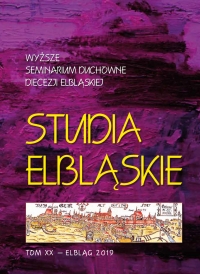Rządca diecezji warmińskiej ks. Wojciech Zink a władze partyjno-państwowe (1951–1953). Zarys problematyki
The ruler of the Warmia diocese, priest Wojciech Zink and the party and state authorities (1951 – 1953). Outline of the problem
Author(s): Andrzej KopiczkoSubject(s): History of Church(es), Local History / Microhistory, Political history
Published by: Wyższe Seminarium Duchowne Diecezji Elbląskiej w Elblągu
Keywords: Wojciech Zink; clergy; church-state relations; repression; church history
Summary/Abstract: In recent years, interest in priest Wojciech Zink, who in 1951 – 1953 governed in the diocese of Warmia, has increased. Much attention is devoted to his attitude towards the then Polish authorities and opposition to the arrest of the Primate of Poland, Cardinal Stefan Wyszyński. He repeatedly defended the clergy and the faithful, who were met with repression by state and party officials. He protested against the arrest of priests. He strongly opposed attempts to reduce parish priesthood and to limit the liquidation of church institutions, especially the lower seminary in Frombork. He defended indigenous priests, but he also tried to preventconflicts because of attempts to restore the German language in services. He did not accept the so-called priests the patriots. Because of his steadfast attitude he was repeatedly called uponto talk to the chairman of the Provincial National Council and the head of the Department for Religious Affairs in Olsztyn. When the Primate of Poland was arrested, he did not agree to read the message of the Council of Ministers and the “summons” of the Polish Episcopate in parishes. For this reason he was arrested in the evening on October 2, 1953 and imprisoned in Warsaw, where he spent 16 months. However, he could return to the diocese only after the transformation of the Polish October in 1956. He spent the next years of his life working in the Bishop’s Curia. He was the closest associate of bishop Tomasz Wilczyński, and after his deathin 1965 – of bishop Józef Drzazga. On their behalf, he often went to provincial authorities, including denominational authorities, to defend the Warmian Church and settle particularly difficult matters, including accusations of priests, pastoral institutions, catechesis and seminary. Back in the 1960s, he defended indigenous people and organized priestly self-help. Thus hefully deserves the term “steadfast priest.” For his heroic attitude he was also commemorated with a plaque unveiled on June 18, 2018 in the Garden of the Righteous in Warsaw.
Journal: Studia Elbląskie
- Issue Year: 2019
- Issue No: 20
- Page Range: 109-126
- Page Count: 18
- Language: Polish

